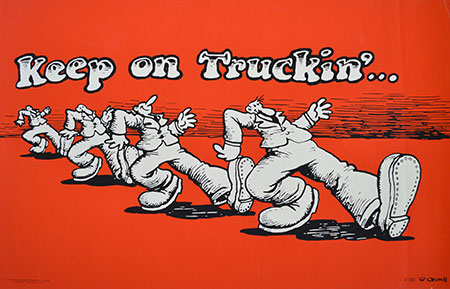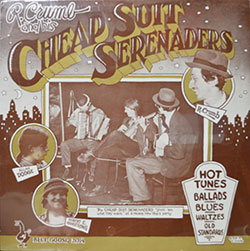
Keep On Truckin’ Poster, R. Crumb, 1967
 Share
Share
The Raymond Danowski and John Martin collection of R. Crumb material is a new addition to the manuscripts at MARBL and has recently been fully processed. Robert Dennis Crumb (R. Crumb) is the most prominent member of the underground comic book genre, or “comix,” and is usually referred to as one of the “fathers” of the movement.
Crumb was born on August 30, 1943 in Philadelphia, Pennsylvania. He was one of the five children of Charles and Beatrice Crumb. While Crumb developed his comics career outside of the mainstream comic publishing industry, he began his work in art as an illustrator for American Greeting Corporation in 1962, taking a job in Cleveland, Ohio after high school. In 1967, he left Cleveland, for San Francisco, California, and became involved with the counterculture whose members gravitated to his work. While he is probably most known for his “Keep Truckin'” comics, other popular characters include Mr. Natural, Devil Girl, and Fritz the Cat. In the 1980s, he created the magazine Weirdo to feature other graphic artists outside of the mainstream. Several years later, Crumb’s friend Terry Zwigoff produced the documentary film Crumb, which received an Oscar nomination. In 1984, Crumb moved to the south of France with his second wife, Aline Kominsky Crumb.

Cover of Jymy-sarjat, 1973
The collection, itself, consists of materials collected by Raymond Danowski and John Martin, relating to R. Crumb and his work. Most of the records are published items–many are comics by Crumb — but there are two unpublished versions of his graphic novel, Big Yum Yum Book: Oggie and the Beanstalk (1963), printed and spiral bound. In addition to his art, there are a number of articles about Crumb and also written by him. Many of these articles were published periodicals dedicated to comics and the culture, but there are a number of articles printed in popular magazines such as People, Esquire, Newsweek, GQ, and The New York Times Magazine. There are also a number of foreign presses represented in the collections with Crumb’s work being featured in El Vibora (Spain), Jymy-sarjat (Finland), and Ekstremisten (Norway). Other printed material includes posters of Crumb’s work as well as artwork by his second wife, Aline, and his younger brother, Maxon.

Cover of R. Crumb and his
Cheap Suit Serenaders LP, 1974
Danowski and Martin also collected a variety of memorabilia. Included in the collection are trading cards that Crumb created for the Topps Chewing Gum Company in 1965 as well as card packs he created with Yazoo Records, a company that used those images on many of the LP records also included in the collection. In addition, there are a number of assorted items — a testament to the varied and erratic interests of Crumb — including a box of Devil Girl chocolates, a bottle of “snake oil,” a bicycle wheel patch kit, rubber stamps, figurines and statuettes, and t-shirts depicting Crumb’s characters and artwork. There are also compact discs, VHS tapes, contact prints, and LP records. The VHS tapes are copies of the film, Crumb, produced by Terry Zwigoff, and the contact prints include images of Crumb and his wife, Aline. The compact discs and LPs are either musical contributions by Crumb’s band, R. Crumb and his Cheap Suit Serenaders; music inspired by Crumb’s work; or albums that feature Crumb’s artwork on the cover, including Big Brother and the Holding Company’s “Cheap Thrills” album.
The Raymond Danowski and John Martin collection of R. Crumb material is an interesting collection that will add to the continued research and interest in American literary culture. The work itself documents the underground comics genre and captures a view of this counterculture movement during the 1960s through the 1980s. Crumb’s satire and distinct view of the world highlight a culture that was brought about by the sale of Zap! Magazine on the street corners of San Francisco in 1968, weird and disturbing and even offensive, but personal and autobiographical.